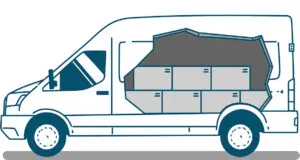Check what you know
Did you know?
Best practice tips
Check what you know
Did you know?
- The EU Parliament Road Safety Group reports that 86% of all rollover accidents involve driver error.
- The centre of gravity (CoG) for delivery vehicles will move due to the changing load.
- The higher the centre of gravity, the easier it is to overturn the vehicle.
- A slope of more than around 33% will usually cause a vehicle to rollover.
As a vehicle empties during the route and the centre of gravity moves, the load may need to be adjusted to improve load stability and stop load movement.
Do not assume that the road ahead is safe, or conditions are unchanged if you have travelled it previously.
Best practice tips
The load in the van must be secure. Movement of the load can affect the centre of gravity of the vehicle, causing it to be unstable to drive and with the potential to rollover.
- Eliminate distractions and always pay attention to the road and how the vehicle is handling.
- Scan the road ahead looking for hazards and changing conditions.
- Sound your horn when you approach tight rural road bends and anticipate oncoming traffic.
- Avoid sudden manoeuvres, over- steering, over-acceleration, and harsh braking.
- To maintain full control and stability of the vehicle and load, reduce speed in rain, fog, snow, or icy conditions, and if the road has a lot of mud, gravel, or debris along its surface.
How a vehicle is loaded can significantly affect its handling on the road and the likelihood of the load moving or becoming unstable during the journey.
The centre of gravity of a loaded goods vehicle tends to be much higher than that of a passenger car. This makes a goods vehicle more likely to rollover than a car at the same speed.
The road design can influence vehicle rollovers as the risk increases when roads bend sharply, or when roads have adverse cambers or ditches running alongside the road.
Multi-drop deliveries can cause drivers issues with their responsibility for the safety and security of the load.
 Drivers must take an adequate amount of time necessary to use appropriate equipment to secure the load properly.
Drivers must take an adequate amount of time necessary to use appropriate equipment to secure the load properly.
Loads should be distributed between axles and the weight spread as evenly as possible, fully utilising the vehicle’s floor area.
Drivers should be wary about axle overloads and moving centres of gravity when removing large portions of the load from either the front or the rear of the vehicle loading area.
Categories


This information sheet is free for employers to download and distribute to their drivers.
It may not be amended in any way | Copyright 2022 National Highways.